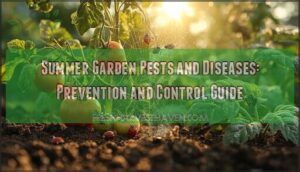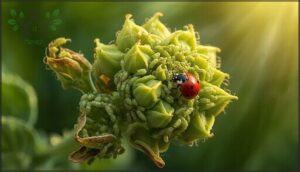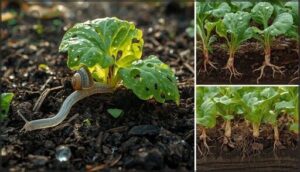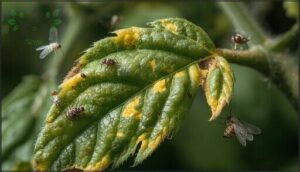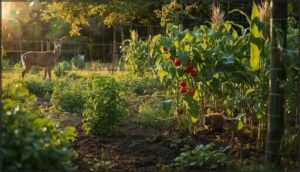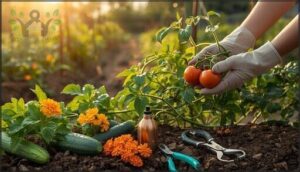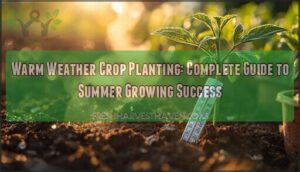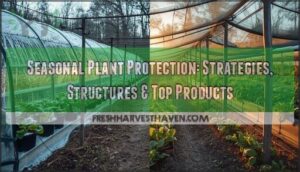This site is supported by our readers. We may earn a commission, at no cost to you, if you purchase through links.
A single aphid landing on your tomato plant can spawn 600 offspring in just three weeks, and by midsummer, that exponential growth can collapse an entire garden bed.
Summer garden pests and diseases don’t announce themselves with warning signs—they establish silent footholds during warm, humid nights when conditions align perfectly for their survival. The combination of heat stress, moisture fluctuations, and dense foliage creates an ecosystem where fungal pathogens like powdery mildew and bacterial infections spread faster than most gardeners can identify them.
Understanding how these threats operate, from the microscopic feeding patterns of spider mites to the lifecycle vulnerabilities of armyworms, transforms your approach from reactive damage control to strategic prevention. The difference between a thriving harvest and a devastated plot often comes down to recognizing early symptoms and deploying the right combination of organic controls before populations explode.
Table Of Contents
- Key Takeaways
- Key Summer Garden Pests and Their Damage
- Common Summer Garden Diseases
- Environmental Factors Increasing Pest and Disease Risk
- Organic and Sustainable Control Methods
- Prevention and Management Strategies
- Frequently Asked Questions (FAQs)
- What is the most common garden pest?
- How do I identify pests in my garden?
- What is the best pest control for vegetable garden?
- How often should I water during summer heat?
- When is the best time to harvest vegetables?
- Can I plant new seeds in midsummer?
- How do I prevent sunscald on tomatoes?
- What mulch works best for moisture retention?
- How do I protect my garden from pest damage during vacation?
- What are the best natural pesticides safe for pets and children?
- Conclusion
Key Takeaways
- Early detection and regular monitoring are crucial for stopping pest and disease outbreaks before they devastate your summer garden.
- Strategic use of organic controls—like beneficial insects, neem oil, and physical barriers—protects your crops without harsh chemicals.
- Proper watering techniques, plant spacing, and healthy soil management dramatically reduce the risk of fungal and bacterial infections.
- Integrated pest management combines prevention, timely intervention, and safe removal of infected material to keep your garden resilient and productive.
Key Summer Garden Pests and Their Damage
Your summer garden faces an array of hungry visitors, from microscopic sap-suckers to large four-legged raiders that can devastate weeks of careful work overnight. Understanding which pests you’re dealing with is the first step toward protecting your plants without resorting to harsh chemicals.
Here’s a breakdown of the most common summer garden pests, the damage they cause, and why they’re drawn to your garden in the first place.
Aphids and Sap-Sucking Insects
Aphids rank among the most persistent garden pests you’ll encounter in summer. These tiny sap-sucking insects multiply rapidly—a single female produces 60–100 offspring in her lifetime, establishing colonies that can reach 1,000 individuals per stem.
Their sap extraction weakens plant health, causing leaf curl and yellowing, while they transmit devastating viral diseases. Biological controls like ladybird beetles offer effective, natural management solutions.
To manage aphid populations effectively, it’s essential to understand aphid life cycles and their impact on plant health.
Caterpillars, Armyworms, and Leaf-Eaters
While aphids weaken plants through sap extraction, caterpillars and armyworms deliver a more aggressive assault—they consume foliage directly. These leaf-eating pests can defoliate your garden rapidly, with armyworms creating transparent, lacy sections across leaves during peak summer activity.
Understanding their lifecycle helps you time interventions effectively:
- Scout plants weekly, checking undersides for eggs and early larvae
- Deploy biological management using Bacillus thuringiensis (Bt) before populations explode
- Remove infested leaves manually for gardens under 60% damage threshold
Early pest monitoring prevents the 50% crop losses you’d face without intervention. Effective armyworm control methods are vital for maintaining a healthy garden.
Slugs, Snails, and Soil-Dwelling Pests
While caterpillars strip leaves visibly, slugs and snails work under cover—especially in cool, moist conditions. These mollusks create irregular holes that devastate seedlings and render crops unmarketable.
Soil-dwelling wireworms tunnel through seeds and stems, causing stand losses up to 80% in severely infested patches. Your garden’s moisture levels and mulch directly influence pest population dynamics.
Understanding their lifecycle lets you time interventions before damage compounds, protecting your yield through strategic slug control methods and soil pest management practices.
Spider Mites, Whiteflies, and Thrips
While slugs work underground, spider mites, whiteflies, and thrips operate at a smaller scale—but their damage is equally devastating.
Spider mites attack over 1,000 plant species, causing leaf stippling and discoloration that progresses to brittleness. Whiteflies trigger premature leaf drop and significant yield losses in tomatoes and squash. Thrips produce silvery streaks on foliage and can devastate crops entirely if unmanaged.
These tiny pests develop pesticide resistance rapidly, making biological solutions and integrated mite management strategies your most reliable defense.
Wildlife Pests (Deer, Groundhogs, Raccoons)
While insects work at the microscopic level, larger wildlife pests—deer, groundhogs, and raccoons—can devastate your entire garden in a single season. Deer browse young seedlings and tender growth, groundhogs consume entire vegetable patches, and raccoons target ripening corn. These animals cause extensive damage through feeding and burrowing, making physical exclusion your most effective defense.
- High-tensile woven wire deer fencing installed at proper heights
- Electric fencing with dual hot wires for raccoon deterrents
- Buried or outward-bent barriers for groundhog trapping prevention
- Strategic placement targeting border rows and vulnerable crops
- Wildlife exclusion as the benchmark for garden protection
Common Summer Garden Diseases
Summer heat and humidity create the perfect breeding ground for fungal, bacterial, and viral pathogens that can quickly devastate your garden. While pests spread disease, many plant problems actually start with the environment itself—warm, wet conditions that favor infection and rapid spread.
Here are the most common diseases you’ll encounter during summer months, along with what to look for.
Powdery and Downy Mildew
Two fungal infections—powdery and downy mildew—can devastate your summer garden, but understanding their disease cycles gives you the upper hand. Powdery mildew thrives in humid conditions above 60%, creating white dusty coatings that stunt growth, while downy mildew prefers cooler, wetter nights and causes yellowing leaves. Both spread rapidly every 3–14 days.
Plant-resistant varieties, improved air circulation, and preventative fungicide applications during peak humidity periods offer your best defense against these fungal foes.
Early Blight, Septoria, and Leaf Spots
When leaf spots appear on your tomato and potato plants, early blight and Septoria leaf spot are likely culprits—and they’ll ravage your harvest without intervention. These fungal diseases start low and climb upward, potentially destroying 50% or more of your foliage during humid summers.
Your defense strategy:
- Monitor lower leaves weekly for circular, dark-bordered lesions
- Remove infected tissue immediately to halt spread
- Apply fungicides at disease severity thresholds to prevent yield losses exceeding 50%
- Space plants generously for airflow and faster leaf drying
Early intervention saves your crop.
Anthracnose and Rust
Anthracnose and rust are fungal diseases that can decimate your summer garden, causing yield losses up to 80% in susceptible crops. These pathogens thrive in humid conditions, creating dark sunken spots and rust-colored pustules on foliage.
Your defense requires disease monitoring, resistant plant varieties, and timely summer fungicides applied every 14–21 days at symptom onset. Crop rotation and proper spacing improve control, protecting your harvest from these relentless fungal threats.
Bacterial Leaf Spot and Wilt
Bacterial leaf spot and wilt can devastate your tomato and lettuce crops, causing yield losses exceeding 40% under favorable conditions. These bacterial garden diseases spread through rain splash, contaminated irrigation, and insect vectors like cucumber beetles. Cool, wet springs and hot, humid summers accelerate disease transmission.
Your defense combines certified seeds, drip irrigation, crop rotation, and soil microbes like Bacillus subtilis, which reduce bacterial wilt incidence by 39–45%, restoring your harvest control.
Viral Infections and Their Symptoms
Viral infections can devastate up to 70–80% of your plant population when conditions align, spreading rapidly through aphids, thrips, and whiteflies. These pathogens cause yellowing, mosaic patterns, stunting, and necrosis that render crops unmarketable. Seasonal peaks occur in spring and early summer, with transmission rates reaching 92% during propagation. Early detection matters—look for:
- Chlorosis and leaf yellowing
- Mosaic or mottled patterns
- Stunted growth and wilting
- Necrotic spots or streaking
- Abnormal flower development
Managing viral load requires resistant varieties, vector control, and removing infected plants immediately to protect your harvest.
Environmental Factors Increasing Pest and Disease Risk
Your garden’s biggest enemy isn’t always a visible pest or disease—it’s often the environment you’ve created.
Summer brings the perfect storm of conditions that pests and diseases absolutely thrive in, from heat and humidity to overcrowding and stress.
Understanding what makes your garden vulnerable is the first step toward stopping problems before they start.
High Temperatures and Humidity
Your summer garden faces its greatest challenge when heat and humidity converge. Warm temperatures around 27°C create ideal conditions for thrips and other pests to multiply rapidly, while high humidity—particularly at 86% relative humidity—extends leaf wetness and accelerates fungal pathogen development.
This climate stress weakens your plants’ defenses, making them vulnerable to infection. Temperature management through strategic watering and choosing heat-resilient varieties helps your garden maintain climate resilience during peak summer months.
Overcrowding and Poor Air Circulation
While heat and humidity set the stage for disease, how you arrange your plants determines whether pathogens take hold. Crowded foliage traps moisture, extending leaf wetness—the critical window when fungal spores germinate.
Proper plant spacing and strategic trellising break that cycle by promoting air circulation. When your tomatoes, beans, and cucumbers have room to breathe, leaves dry faster after rain, dramatically reducing disease severity during warm, wet periods.
Excess Rainfall and Irrigation Practices
While spacing creates airflow, your irrigation method determines whether moisture lingers on leaves long enough for infection. Overhead watering dramatically accelerates fungal diseases like powdery mildew compared to drip irrigation, since water films on foliage fuel spore germination.
Heavy rainfall events similarly spike pathogen populations by dispersing fungal spores across your garden.
Switch to drip irrigation and water early morning to allow leaves to dry quickly, markedly reducing disease incidence during humid summers.
Plant Stress and Nutrient Imbalance
Beyond irrigation, your plants’ internal health matters just as much. Drought stress weakens plant defenses by slowing protective chemical production, while nutrient imbalances—especially excess nitrogen—create lush, attractive foliage that invites aphids and fungal diseases.
Maintain consistent soil moisture and balanced fertilization to build drought tolerance and vigor. Water-stressed plants can’t heal wounds quickly, giving opportunistic pathogens easy entry.
Think of it this way: a well-nourished, hydrated plant resists pests far better than one struggling under stress and nutrient cycling disruptions.
A well-nourished, hydrated plant resists pests far better than one struggling under stress and nutrient imbalance
Organic and Sustainable Control Methods
For managing summer pests and diseases, you don’t need harsh chemicals to get real results. Nature offers plenty of effective solutions—from beneficial insects that hunt down pests, to simple sprays you can make at home, to physical barriers that keep damage at bay.
Let’s walk through the organic methods that’ll help you protect your garden while keeping it healthy and sustainable.
Natural Sprays and Homemade Remedies
Ready to fight back naturally? Neem oil outperforms synthetic options, reducing pest larvae by 80–95% while sparing beneficial insects. Garlic spray combats fungal diseases with proven potency, while diatomaceous earth controls slugs with 84% effectiveness. Pyrethrin spray delivers rapid knockdown of flying insects.
However, vinegar solutions and homemade soap require frequent reapplication every 2–3 days for minimal results.
For serious fungal threats, copper-based fungicides and horticultural oils provide reliable, long-lasting protection your garden deserves.
Beneficial Insects and Biological Controls
Mother Nature’s workforce—beneficial insects and biological agents—can dramatically shift your pest control outcomes. Leverage these natural allies through strategic releases:
- Lady beetles consume 200–300 aphids during development, reducing populations by 73–88% within weeks
- Parasitoid wasps (Trichogramma) lay up to 300 eggs, preventing subsequent caterpillar damage
- Predatory mites suppress thrips and spider mites without chemical intervention
- Entomopathogenic nematodes target soil-dwelling pests like fungus gnats year-round
This garden ecology approach integrates microbe management with insect allies for sustainable pest suppression.
Physical Barriers, Fencing, and Row Covers
When beneficial insects need backup, physical barriers become your garden’s fortress. Row covers made of 0.5-ounce spunbond fabric exclude up to 100% of aphids and flea beetles when properly sealed at planting, while exclusion netting reduces cucumber beetle damage by over 80%.
For wildlife threats, woven-wire fencing at least 8 feet tall provides near-total deer exclusion lasting 20–30 years. Combine welded-wire mesh with below-ground barriers to deter rodents and woodchucks.
These barrier methods boost yields by 15–25% and require only routine annual maintenance to prevent breaches.
Companion Planting and Crop Rotation
When pests return season after season, your soil’s ecosystem may be working against you. Companion planting and crop rotation rebuild that balance by strengthening your soil microbiome and disrupting pest lifecycles.
Intercropping tomatoes with onions cuts disease by 35%, while four-year rotations boost organic matter by 10–18%, enhancing natural defenses.
These polyculture methods create ecological balance that protects your garden for years, requiring less intervention and building long-term resilience through crop diversity and preventative measures.
Prevention and Management Strategies
Now that you understand what pests and diseases threaten your garden, the real work begins—stopping them before they take hold. The good news is that prevention works far better than treatment, and most strategies are straightforward enough to fit into your regular gardening routine.
Here’s what you need to know to keep your garden healthy all summer long.
Early Monitoring and Pest Identification
Catching pests early is your best defense against summer devastation. Regular pest surveillance every 5-7 days—using sticky traps, magnification, and visual inspection—detects infestations before damage becomes visible.
Early warning systems like monitoring tools and disease forecasting help you identify pest tracking data at densities below economic thresholds.
This proactive approach to plant disease management reduces treatment costs by 67% and crop losses by up to 35%, giving you genuine control over your garden’s health.
Healthy Soil and Proper Mulching
Your soil is the foundation of disease resistance, and enriching it transforms your garden’s resilience. Healthy soil with at least 5% organic matter retains moisture and nourishes beneficial microbes that suppress fungal pathogens naturally.
Proper mulching delivers impressive benefits:
- Reduces surface evaporation by up to 75%, maintaining consistent moisture
- Moderates soil temperature during heat stress
- Decreases pathogen spread through improved soil structure
- Contributes organic matter as it decomposes, enhancing nutrient cycling
Build soil health through compost and crop rotation—your plants will thrive.
Watering Techniques to Reduce Disease
While mulch builds your soil foundation, how you water makes all the difference in controlling fungal diseases. The method and timing of irrigation directly shape the microclimate around your plants—determining whether leaves stay dry or remain wet long enough for pathogens to establish.
Your irrigation choices fall into two categories: those that wet foliage, and those that don’t. Drip irrigation delivers water directly to the root zone, bypassing leaves entirely. Overhead systems, by contrast, saturate everything—creating prolonged leaf wetness that invites powdery mildew, downy mildew, and leaf spot diseases to thrive.
The difference is dramatic. In recent onion studies, sprinkler irrigation produced 36% greater leaf wetness than drip systems, resulting in 170% higher foliar disease severity and 186% more bulb rot. California spinach trials showed even starker results: downy mildew incidence dropped two to five times lower with drip irrigation compared to sprinkler systems, all while maintaining comparable yields and cutting fungicide costs by roughly $300 per acre.
If you’re already committed to drip irrigation, timing remains important. When overhead watering is necessary, apply it early morning—ideally between 5 and 9 a.m.—so foliage dries quickly during daylight hours. Evening irrigation leaves moisture lingering through cool nights, creating a 12-hour infection window for fungal spores. Morning watering shortens that window dramatically.
Soil moisture management deserves equal attention. Over-irrigation saturates conditions around roots, favoring soil-borne pathogens like root rot and crown rot that require free water to spread. Under-irrigation stresses plants, reducing their natural defenses. Your target isn’t constant wetness—it’s a balanced moisture level that keeps roots hydrated while allowing soil to breathe. Using soil sensors or the simple feel test (squeeze moist soil; it should clump but crumble easily) helps you water only when needed.
Consider your soil type too. Clay soils hold water longer and shed runoff quickly, which spreads soil-borne diseases across your beds. Slower, longer irrigation sets on clay prevent both saturation and splash-dispersal. Sandy soils drain faster, so you’ll water more frequently but with shorter intervals—keeping moisture in the root zone without creating boggy conditions overhead.
Here’s how these approaches stack up:
| Irrigation Method | Leaf Wetness | Disease Risk | Best Use |
|---|---|---|---|
| Drip irrigation | Minimal | Low | Primary choice for disease prevention |
| Morning overhead (5–9 a.m.) | Moderate | Moderate | Secondary option with careful timing |
| Evening overhead | High | High | Avoid—creates overnight infection window |
The bottom line: switch to drip irrigation where feasible, and if you use overhead systems, water early and water smart. Your plants will reward you with vigor and health.
Integrated Pest Management (IPM) Practices
Watering smart sets the stage, but Integrated Pest Management (IPM) brings all your strategies together. IPM combines pest monitoring, threshold management, biological control, and targeted interventions to keep pests and diseases below damaging levels—not eliminate them entirely.
You’ll scout regularly, identify problems early, and deploy cultural, mechanical, and biological tactics before reaching for pesticides. This layered approach maintains balance while protecting beneficial insects, reducing costs, and building long-term garden resilience through sustainable practices rooted in observation and prevention.
Safe Removal and Disposal of Infected Material
IPM works when you catch problems early—but once disease strikes, swift sanitation becomes your frontline defense. Removing infected debris immediately cuts disease prevalence by up to 60%, stopping fungal infections like powdery mildew from spreading further.
Follow these biohazard control steps for proper waste disposal:
- Prune during dry weather to reduce pathogen transfer by 35–50%
- Disinfect tools after handling infected material using approved garden disinfectants
- Bag symptomatic plant debris separately—never compost diseased tissue at home
- Deep-bury or incinerate regulated pathogens per local guidelines
Industrial composting above 55°C destroys fungal spores completely, but backyard piles rarely reach safe temperatures. Clean boots and equipment after contact with contaminated soil—this simple habit lowers soil-borne pathogen spread by 91%. For viral outbreaks, immediate removal limits disease expansion to less than 5% of remaining plants.
Proper sanitation methods protect your garden’s future and prevent reinfection cycles that undermine all your prevention work.
Frequently Asked Questions (FAQs)
What is the most common garden pest?
Aphids reign as the most troublesome visitors in home gardens, with populations regularly exceeding 198 per twig during peak season—no wonder pest identification starts with these persistent sap-suckers.
How do I identify pests in my garden?
You can identify pests by examining damage patterns, checking for insect frass or silvery trails, spotting cast skins or stippling, and inspecting leaf undersides during morning garden inspections for accurate pest signatures.
What is the best pest control for vegetable garden?
While chemical sprays promise fast results, the best pest control for your vegetable garden combines neem oil sprays, botanical insecticides, and pest-resistant varieties with organic fungicides and garden sanitation—a true organic gardening methods approach.
How often should I water during summer heat?
During extreme heat, water your vegetable garden daily or every other day when temperatures exceed 90°F.
Check soil moisture at finger depth—if it’s dry 2–3 inches down, it’s time to irrigate deeply.
When is the best time to harvest vegetables?
Harvest timing is like catching a wave—too early or late, and you miss the sweet spot. Pick vegetables when they reach vegetable maturity in early morning, maximizing crop yield and flavor while encouraging harvest frequency for continuous summer garden production.
Can I plant new seeds in midsummer?
Yes, you can plant new seeds in midsummer. Root crops like carrots and beets, plus bush beans, thrive when sown in July. Focus on fast-maturing varieties and maintain consistent soil moisture for best seed germination.
How do I prevent sunscald on tomatoes?
To keep your tomatoes from scalding, preserve their leaf canopy—it cuts sunscald by 80%. Add shade cloth, mulch roots well, choose resistant varieties, water consistently, and never overprune during peak sun.
What mulch works best for moisture retention?
Wood chip mulch offers excellent moisture retention, holding water like a sponge while reducing soil evaporation.
Plastic film provides maximum conservation, cutting evaporative losses by roughly 70% compared to bare garden soil.
How do I protect my garden from pest damage during vacation?
Set up automated watering systems to prevent plant stress—studies show soil-moisture sensors reduce supervision to weekly checks.
Install garden fencing for wildlife, apply pest deterrents, and schedule professional pest control before your vacation planning begins.
What are the best natural pesticides safe for pets and children?
Botanical pesticides like neem oil, insecticidal soap solutions, and diatomaceous earth offer proven pest management without risking your family’s safety.
Biological controls—beneficial insects and Bt sprays—complete your integrated pest management toolkit, protecting plants while keeping children and pets secure.
Conclusion
A single overlooked leaf spot can unravel months of careful cultivation, but armed with these strategies, you won’t let summer garden pests and diseases dictate your harvest. Early monitoring, strategic prevention, and timely intervention create an ecosystem where beneficial organisms outcompete threats before damage escalates.
Your garden’s resilience depends on consistent observation and decisive action. Approach each growing season as both scientist and steward, and you’ll consistently outmaneuver the most persistent adversaries nature sends your way.
- https://www.bhg.com/pest-predictions-spring-summer-2025-11703709
- https://extension.entm.purdue.edu/newsletters/pestandcrop/article/13038/
- https://www.arrowexterminators.com/learning-center/blog/stay-one-step-ahead-of-pests-with-these-2025-bug-predictions
- https://www.raid.com/en-us/education/the-state-of-the-bug
- https://www.epicgardening.com/garden-diseases-summer/

